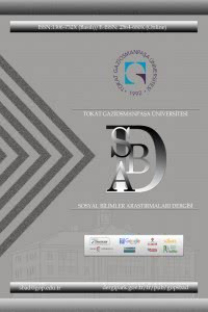Öğretmen Adaylarının Değişkenlerin Kullanımı ile İlgili Bilgileri
Bu çalışmada öğretmen adaylarının değişkenler hakkındaki bilgileri incelenecektir. Üç farklı üniversiteden ve farklı sınıflardan 184 öğretmen adayından anketlerle veri toplanmıştır. Bu anketlerin kategorilere konularak analizinden sonra 10 öğretmen adayı seçilip röportaj yapılmıştır. Öğretmen adayları harfleri, alışkın olduğu durumlarda yani harflerin bilinmeyen rolü aldığı durumlarda kolayca kullanıyorlar. Diğer yandan harfleri genel sayı ya da fonksiyonlarda değişken olarak kullanmada zorlanıyorlar. Soruların seviyesine uygun ispat çeşitlerini kullanmıyorlar. Cevapları, rutin sorulara şipşak cevaplar vermeye hazır olduklarını gösteriyor. Bu çeşit bir anlayış ‘eylem seviyesinde’ bir anlayış olarak etiketlendirilebilir. Bu sorunun altında yatan ana sebep okullarımızda öğrencilerimizin en kısa sürede doğru cevabı bulmayı empoze edilmesiyle ilgili olabilir. Bu nedenle manayı bir kenara bırakıp, doğru cevabı bulmaya odaklanıyor olabilirler. Öğrencilerin manaya önem vermelerine yardımcı olmak için öğrencilerin öğrenmelerinin her aşamasında manayı aramalarına olanak sağlayacak sınıf ortamları oluşturmalıyız
Anahtar Kelimeler:
Öğretmen adayları, bilgi, anlama, değişkenler, bilinmeyen, genel sayı
Prospective Teacher’s Knowledge of Principal Uses of Variables
In this study, prospective teachers’ knowledge of principal uses of variables will be explored. 184 prospective mathematics teachers from three different universities and different year groups completed a questionnaire. After analysing the questionnaires by means of categorisation of responses, 10 students were selected and interviewed. The results indicate that prospective teachers are comfortable with using letters in familiar contexts where the variables assume the role of unknowns. On the other hand, students have difficulties in using letters as generalised numbers or arguments in functional relationships. They could not give appropriate kinds of proof according to the level of questions. Their responses show that they are accustomed to produce mechanistic answers to routine questions. This kind of understanding can be labelled as ‘action level’ of understanding. The main underlying reasons of such problems may be due to the fact that at schools students are imposed to get the right answers in a shortest possible time. Therefore, they put the meaning aside, and focus on getting answers right. In order to help students to give importance to meaning, educators have to create classroom contexts where students are searching for meaning at every stage of learning
Keywords:
Prospective teachers, knowledge, understanding, variables, unknown, generalized number,
___
- Bell, A. (1995). Purpose in school algebra. The Journal of Mathematical Behaviour, 14(1), 41-73.
- Booth, L.R. (1984). Algebra: children's strategies and errors. Windsor: NFER- Nelson
- Eisenberg, T. (1991). Functions and associated learning difficulties, in D. Tall, (Ed.) Advanced Mathematical Thinking, Dordrecht / Boston / London: Kluwer Academic Publishers, 140-171.
- Filloy, E. & Rojano, T. (1989). Solving equations: The transition from arithmetic to algebra, For the Learning of Mathematics, 9(2), 19-25.
- Goulding, M. & Suggate, J. (2001) Opening a can of worms: Investigating primary teachers' subject knowledge in mathematics, Mathematics Education Review, 13, 41-53.
- Gray, E. M. & Tall, D. O. (1994). Duality, ambiguity and flexibility: a proceptual view of simple arithmetic. Journal of Research in Mathematics Education, 26 (2), 115–141.
- Harper, E. (1987). Ghosts of Diophantus. Educational Studies in Mathematics, 18, 75-90.
- Herscovics, N., & Linchevski, L. (1994). A cognitive gap between arithmetic and algebra. Educational Studies in Mathematics, 27, 59-78.
- Kieran, C. (1992). The learning and teaching of school algebra. In D.A. Grouws (Ed.), The Handbook of research on mathematics teaching and learning (pp. 390- 419). New York, NY: Macmillan.
- Kücheman, D. (1981). Algebra. In K. Hart (Ed.), Children's understanding of mathematics: 11-16 (pp. 102-119). London: John Murray.
- Lee, L. & Wheeler, D. (1989). The arithmetic connection. Educational Studies in Mathematics. 20, 41-54
- Leitzel, J. R. (1989). Critical Considerations for the Future of Algebra Instruction, In S. Wagner & C. Kieran (Eds.), Research issues in the learning and teaching of algebra (pp. 25-32). Hillsdale, NJ: Lawrence Erlbaum.
- Philipp, R. A. (1992). The many uses of algebraic variables. Mathematics Teacher, 85(7), 557-561.
- Schoenfeld, A. H., & Arcavi, A. (1988). On the meaning of variable. Mathematics Teacher, 81(6), 420-427.
- Sfard, A., & Linchevski, L. (1994). The gains and the pitfalls of reification - the case of algebra. Educational Studies in Mathematics, 26, 191-228.
- Sierpinska, A. (1994). Understanding in Mathematics, London / Washington D.C.: The Falmer Press
- Ursini, S. & Trigueros, M. (2001). A model for the uses of variable in elementary algebra, in M. van den Heuvel-Panhuizen, (Ed.) Twenty fifth Conference of the International Group for the Psychology of Mathematics Education, (Vol. 4, pp. 327-333). Utrecht: The Netherlands.
- Ursini, S., & Trigueros, M. (1997). Understanding of different uses of variable: A study with starting college students. Proceedings of the Twenty-First International Conference for the Psychology of Mathematics Education (Vol. 4, pp. 254- 261). Lahti, Finland.
- Usiskin, Z. (1988). Conceptions of school algebra and uses of variables. In A. Coxford & A. P. Schulte (Eds.), Ideas of algebra, K-12 (1988 Yearbook: 8-19). Reston, VA: National Council of Teachers of Mathematics.
- YÖK 2000, Selection and Placement of Students in Higher Education Institutions in Turkey, Retrieved 2003, from http://www.osym.gov.tr/eng/index.html.
- ISSN: 1306-732X
- Yayın Aralığı: Yılda 2 Sayı
- Başlangıç: 2006
- Yayıncı: Gaziosmanpaşa Üniversitesi Sosyal Bilimler Enstitüsü
Sayıdaki Diğer Makaleler
Demokratik ve Şeffaf Yönetimi Anlamlandıran Bir Hak: ‘Bilgi Edinme Hakkı’
Ebru ŞİMŞEK İMREN, Ahmet GÜVEN
Gerçek Bir İkilem: Ödev Vermek Ya da Vermemek?
Eğitimde Araştırma Yöntemleri: İngilizce Öğretmenliği Hizmet Öncesi Eğitim Üzerine Bir Çalışma
Öğretmen Adaylarının Değişkenlerin Kullanımı ile İlgili Bilgileri
Sınıf İçi Gözlem Araç ve Teknikleri: Kavramsal Bir Çözümleme
Ebru OĞUZ ÇUHADAROĞLU, Kürşad YILMAZ
Türkçe Ders Kitaplarında Yer Alan Edebi Metinlerin Öğrencilere Estetik Zevk Kazandırmadaki Rolü
